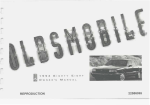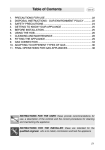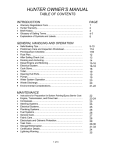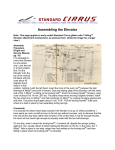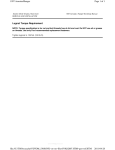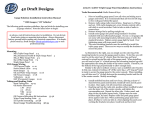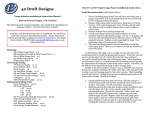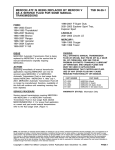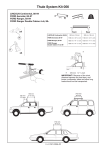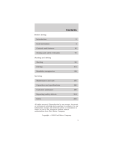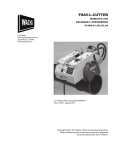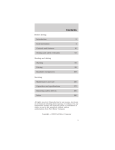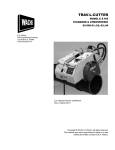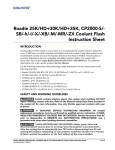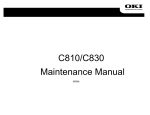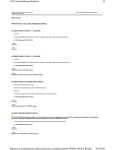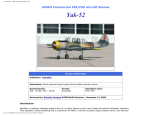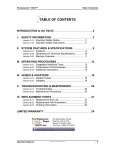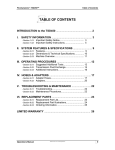Download 06-00 Brake System, Service
Transcript
1997 Aerostar/Ranger Section 06-00: Brake System, Service DIAGNOSIS AND TESTING Page 1 of 7 1997 Aerostar, Ranger Workshop Manual Inspection and Verification When it comes to today's electrically controlled RABS/4WABS, the diagnosis of many concerns requires following the diagnostic procedures exactly as they are outlined in the service manual. But there is more to it than that. You have to take the information given you by the customer, and combine it with your understanding of brake systems in general. This knowledge and information will help you make the most efficient use of the diagnostic procedures in this manual. Getting Started Brake system diagnosis starts with the customer's concern. It is best to get this information directly from the customer, not just from a service write-up. Customers usually do their best to describe what they have been experiencing and what their concerns are. But it is often necessary to ask questions and probe further in order to get a complete picture of the problem. Customers may report that the brake pedal (2455) went to the floor, when it actually only dropped part way. Remember, customers get used to how their vehicle's brakes are performing. If the system suddenly behaves differently, they may become alarmed. Under these circumstances, what they report may not be as clearly stated as it could be. Your job is to listen carefully and ask probing questions about anything that doesn't fit your experience and understanding of brake system functioning. Verify the Complaint Once you are satisfied that you understand the customer's concerns, take the vehicle on the road yourself. Many brake concerns involve a wide variety of noises and pulsations that can only be experienced while operating the vehicle. Make sure the vehicle's tires are inflated properly. Make your brake application evaluation on level, dry, hard, smooth pavement that is free from oil, grease or loose dirt. Back in the Shop The next step in servicing a brake complaint is a thorough inspection of the system. Brake Master Cylinder Look for leaks. Clean the unit and remove the brake master cylinder filler cap. Check the fluid level. Check the condition of the gasket. Hydraulic Leaks On vehicles with power brakes, with the engine (6007) running, apply 667 N (150 lbs.) force to the brake pedal and hold for ten seconds. If brake pedal height cannot be maintained for 10 seconds or the brake warning light comes on, service is required. Occasional brake squeal can be caused by environmental conditions such as cold ambient temperatures, heat, rain, snow, salt, mud, hot ambient temperatures or high humidity. This occasional squeal is not a functional problem and does not indicate any loss in brake effectiveness. Visually examine front and rear tires and wheel assemblies for damage such as uneven wear, tread washouts, or sidewall damage. Make sure the tires are of the same size, type and, where possible, same manufacturer. Any tire or wheel (1007) that is damaged should be replaced. Refer to Section 04-04 . Wheels and tires must be cleared of any foreign matter, and tire pressures adjusted to the correct file://C:\TSO\tsocache\VDTOM_5368\SVK~us~en~file=SVK60011.HTM~gen~ref.HTM 2011-04-28 1997 Aerostar/Ranger Page 2 of 7 specification as detailed in Section 04-04 . If tires exhibit uneven wear or feathering, the cause must be corrected. Check steering and suspension components for damage/wear and, if necessary, check and adjust steering alignment. Refer to Section 0400 . Road Test A road test should be performed to compare actual vehicle braking performance with the performance standards expected by the driver. The ability of the test driver to make valid comparisons and detect performance deficiencies will depend on experience. The driver should have a thorough knowledge of brake system operation and accepted general performance guidelines, in order to make good comparisons and detect performance problems. An experienced brake technician will always establish a route that will be used for all brake diagnosis road tests. The road selected will be reasonably smooth and level. Gravel or bumpy roads are not suitable because the surface does not allow the tires to grip the road equally. Crowned roads should be avoided because of the large amount of weight shifted to the low set of wheels on this type of road. Once the route is established and consistently used, the road surface variable can be eliminated from the test results. A key factor in evaluating brake concerns is the deceleration rate. During braking, all of us are sensitive to whether or not the vehicle is slowing at the rate we have come to expect. This varies from vehicle to vehicle and with changes in operating conditions. It is evident how well the brakes on a particular vehicle are working after just a few applications. Stopping Distance Method For this test, you need to mark out or find a driving lane that is 3.7m (12 ft.) wide. You also need to place two markers along this lane, 7.5m (25 ft.) apart. At a speed of 32 km/h (20 mph), drive down the center of the lane and apply the service brakes when you reach the first marker. Observe whether the vehicle comes to a smooth stop before the second marker. Also note whether it pulled to the right or left and whether it went beyond the 3.7m (12 ft.) width. For trucks under 4500 kg (10,000 lbs.) a commonly accepted standard is a smooth stop within 7.5m (25 ft.), while staying within the lane. Before a road test, get a complete description of the customer concerns or suspected condition. From the description, experience will allow possible causes to be matched with symptoms. Certain components will be tagged as possible suspects while others will be eliminated by the evidence. More importantly, the customer's description can reveal unsafe conditions which should be checked or corrected before the road test. The description will also help form the basic approach to the road test by narrowing the problem to specific components, vehicle speed or conditions. The road test should begin with a general brake performance check. With the customer's description as a guide, the brake system should be tested at different vehicle speeds using both light and heavy brake pedal pressure. On vehicles with rear drum brakes, to determine if the problem is in the front or rear braking system, the service brake pedal is used first, then the parking brake. If the condition (i.e., pull, vibration, pulsation) occurs only with the parking brake, the problem is in the rear system. If the condition occurs when the service brake pedal is pressed, the problem is in the front system. Vehicles with rear disc brakes require further testing to determine problem location. Locking the brakes and sliding the tires should be avoided. Locked brakes and sliding tires do not indicate brake efficiency: A heavily braked and turning wheel will stop the vehicle in less distance than locked brakes. If the problem becomes evident during this check, it should be determined if it fits the description given before the road test. If the problem is not evident, an attempt should be made to duplicate the condition using the information from the description. file://C:\TSO\tsocache\VDTOM_5368\SVK~us~en~file=SVK60011.HTM~gen~ref.HTM 2011-04-28 1997 Aerostar/Ranger Page 3 of 7 If a concern exists, the brake system symptom chart in this section should be used, in order to isolate it to a specific subsystem and condition description. From this description, a list of possible causes can be used to further narrow the cause to a specific component or condition. Pedal Reserve To check brake pedal reserve with the engine running, apply 667 N (150 lbs.) force and observe the extent of brake pedal travel. There should be at least 20% reserve travel distance available. Hydraulic Parts Check hydraulic hoses and tubes for leaks, cracks, chafing, and distortions. The fasteners that hold these components in place should also be checked. Wheel Cylinder — Drum Brakes NOTE: Don't pry under or otherwise disturb the dust boot. This may destroy a very important seal. If there is leakage, it will find its way around the dust boot. With the brake drum (1126) removed, check for loose or worn parts. Check the rear wheel cylinder (2261) for leakage around the dust boot. Disc Brake Caliper Check for proper installation, leakage, caliper slide lubrication and excessive wear along caliper supports. Dual Circuit Warning Light Functions: Apply the parking brake. Check that the light comes on when you start the engine. Release the parking brake. Check that the brake warning light goes off. file://C:\TSO\tsocache\VDTOM_5368\SVK~us~en~file=SVK60011.HTM~gen~ref.HTM 2011-04-28 1997 Aerostar/Ranger Page 4 of 7 Detecting Causes of Brake Problems ABS brake systems, with their electronically-controlled components, provide a greater degree of braking control than ever before. The fault codes generated by the built-in diagnostics make solving many concerns a simple matter. However, it isn't always possible to immediately nail the culprit when something isn't working properly. Eliminate the obvious first, and gradually close in on the real concern. Start with the clues found during basic inspection. Correct the obvious problems and see how that affects the performance of the system. Save the potentially difficult possibilities for last. Many times, the concern will be corrected before you have to get into more challenging areas. The most difficult concerns are often intermittent. Make sure the problem is really an intermittent brake issue and not an intermittent operating condition. Get as much information as possible. Talk to the primary driver. Find out how often it actually happens, what time of day, what the load is, what the road conditions are and what the weather is like. Listen carefully. There may be important clues in the answers. Isolating ABS WARNING: DO NOT DISABLE THE FRONT BRAKES. IF YOU DO, STOPPING DISTANCES MAY BE EXTREMELY LONG, ESPECIALLY IN VEHICLES THAT ARE UNLOADED. Many concerns that seem at first to be ABS related are actually problems with the base brake system. On the rear anti-lock systems (RABS) pull the brake fluid level sensor connector and fasten it safely out of the way. This will effectively disable the RABS, but leave the normal power assisted brake system functioning normally. Road test the vehicle. With RABS disabled, you will get a good feel for the functioning of the base brake system and any concerns. Fix these concerns before testing the ABS itself. This procedure will demonstrate the vehicle's deceleration before lockup. This will help evaluate the vehicle's braking performance after correcting all concerns. Use one of the deceleration tests referred to earlier for accurate measure of the deceleration rate. With the RABS disconnected, test for brake imbalance. Apply pressure quickly to detect one wheel locking up before the other. With RABS functioning, this judgment can't be made. Reactivate the RABS to check for the pedal pulsation. Remember that the RABS shuts off below approximately 8 km/h (5 mph), which can result in lockup at the conclusion of a stop. Operate vehicle safely to reach speed when testing. Premature RABS Activation One concern that may be a challenge to isolate is premature RABS activation. The first step is to thoroughly check out the base brake system. If the base brake system checks out and there is still premature RABS activation, there are several areas to take a close look at: A weak sensor signal: Look for a bad wheel speed sensor, chips on the pole piece or an air gap that's too high. A wiring problem: Look for chafed wires that might be causing a faulty electrical circuit. A rear axle problem: Rear axle malfunctions account for many premature RABS activation file://C:\TSO\tsocache\VDTOM_5368\SVK~us~en~file=SVK60011.HTM~gen~ref.HTM 2011-04-28 1997 Aerostar/Ranger Page 5 of 7 problems. Look for rear axle speed sensor ring damage and for play in the differential that allows the rear axle speed sensor ring to move away from the wheel speed sensor. The "Rolling Skid" NOTE: Some initial, momentary wheel lockup is permissible during this test. ABS are designed to sense the RAPID deceleration rate of a wheel. This is what warns of possible lockup. Some tires have high peak traction which tends to fall off rapidly. When a tire has this characteristic, the ABS can easily perform as designed. When increasing the braking force, the tires rapidly decelerate, and at the appropriate point, the ABS kicks in at the wheel or axle that needs reduced pressure. Brake pedal pulsations can be felt, and on 4WABS the pump motor can be heard. Tires with a tendency to develop peak traction which then falls off more slowly may slip some as they decelerate (sometimes referred to as a "rolling skid"). This was a typical characteristic of bias belted tires. This condition may cause the ABS system not to activate, because the wheel isn't fully locking up. There may, however, be considerable squealing and smoking of the tires, and sometimes even skid marks. This is a concern the customer may report. Have the customer take you for a drive to demonstrate. Observe how the driver activates the brakes. Before beginning the test, adjust the outside rearview mirrors so you can observe the rear wheels. Have the owner apply the brakes normally during a hard stop. Ford recommends speeds of no more than 24 km/h (15 mph) for this test. If you feel the ABS activate, rolling skid isn't the problem. If the ABS doesn't activate, have the driver increase the pressure until they squeal and smoke. Hold in this position. Observe rearview mirrors for evidence of smoke. It is also helpful to have an assistant standing nearby who can watch the wheels from a better angle during the test. Check to see if the wheels continue to rotate for the duration of the stop. Finally, see if increasing the pressure even more will cause the ABS to activate. If it does, the vehicle is experiencing the slow drop-off from peak traction discussed above. This last step, applying extra pressure, is very important to the diagnosis. Many drivers back off on the brakes when they hear the squeal because they think, and understandably so, that a wheel or wheels are locking up. Correcting this problem may mean explaining that the system is functioning fine and the wheels are not locking up. RABS and 4-Wheel Drive When diagnosing RABS concerns on a 4-wheel drive vehicle, remember that the front and rear drivetrains are mechanically locked together in 4-wheel drive. If the front wheels turn, the rear wheels turn. If the front wheels lock up, the rear wheels lock up. The RABS can't prevent lockup in the rear when the front brakes are applied hard enough to cause lockup on low-traction surfaces. For more information on the rear anti-lock brake system (RABS), refer to Section 06-09A . For more information on the four wheel anti-lock brake system (4WABS), refer to Section 06-09B . The Vehicle That Keeps Coming Back If you get a vehicle that has been brought in for brake service frequently, take a close look at the service history. How long did that vehicle go before its first brake service? What has happened since? If components have been replaced, are they the correct parts? Recurring problems can be the result of some mistake made earlier in the service history. file://C:\TSO\tsocache\VDTOM_5368\SVK~us~en~file=SVK60011.HTM~gen~ref.HTM 2011-04-28 1997 Aerostar/Ranger Page 6 of 7 Brake Pedal Feel and Stopping Distance A combination of things indicates whether brakes are working properly: The feel of the brake pedal, how rapidly the vehicle slows down and distance travelled before stopping. If the brakes are working properly and we experience the expected feel and results, we are confident. If the brakes feel different and/or the vehicle doesn't slow or stop as expected, we feel uneasy. . .even panicked. This panic will be heightened in emergency stopping situations. Customers often report brake problems in terms of brake pedal feel. "My brakes feel spongy" or "The brake pedal went to the floor" or "The brakes feel hard and I have to apply much more force than usual" are all possible customer complaints. These complaints are often accompanied by reports that the vehicle "Just didn't stop the way it should." These simple complaints may indicate problems that are much more complex to diagnose and correct. What makes understanding brake feel and stopping distance a challenge is that different brake systems have a different feel and a different braking response. Feel is the result of several factors: Stopping Perceptions Design Brake feel will vary from vehicle to vehicle, even of the same design depending on how the vehicle is equipped. Operation How the vehicle is used may also change the feel of the brakes. Factors such as loading, trailer towing and operating on steep grades or gravel roads can all affect the feel of the brakes. Pedal Force and Travel file://C:\TSO\tsocache\VDTOM_5368\SVK~us~en~file=SVK60011.HTM~gen~ref.HTM 2011-04-28 1997 Aerostar/Ranger Page 7 of 7 The amount of force applied, combined with the amount of brake pedal travel will affect the feel and stopping response. Some drivers are stronger than others and can force the brake pedal down further. Spring or Give in the System This is a very important concept. A braking system isn't rigid. Every part has some give. For example, the disc brake calipers (2B120) flex a little as force is applied, flexible hoses swell a little under pressure, and shoe return springs are extended. The combination of these and other points where the system gives a little results in a "springiness" that "fights back" against the hydraulic pressure. This "fighting back" is felt through the brake pedal. As parts of the system become worn or corroded, this "fighting back" feel may change. file://C:\TSO\tsocache\VDTOM_5368\SVK~us~en~file=SVK60011.HTM~gen~ref.HTM 2011-04-28 1997 Aerostar/Ranger Page 1 of 9 Section 06-00: Brake System, Service DIAGNOSIS AND TESTING 1997 Aerostar, Ranger Workshop Manual Symptom Chart — Brake System Service BRAKE SYSTEM SERVICE Condition Brakes Not Working, Excessive Pedal Travel, Brake Pedal Feels Spongy When Fully Applied Possible Source Action Low fluid level. ADD fluid, BLEED system, CHECK for leaks, and BLEED system. Worn or damaged four wheel ABS hydraulic control unit (Ranger only). REFER to Section 0609B , Symptom Chart. Worn or damaged RABS valve accumulator or outlet (dump) valve REFER to Section 0609A , Symptom Chart. Rear brakes out of adjustment. ADJUST rear brakes. REFER to Section 0602 . Front wheel bearing out of adjustment. ADJUST front wheel bearings. REFER to Section 04-01A for all 4x2 vehicles, Section 05-03A for Ranger and Section 04-01C for Aerostar 4x4. Brake master cylinder or booster dash unit mounting loose. TIGHTEN nuts and bolts to specification. Disc brake caliper attachment loose. REPLACE or TIGHTEN as required. Worn or damaged brake shoe adjusting lever cables . REMOVE drum and CHECK lining for proper adjustment. REPLACE brake shoe adjusting lever cables. REFER to Section 0602 . Glazed, worn, scored or damaged brake linings. REPLACE rear brake shoes and linings. REFER to Section 0602 . Drums out of round or rotors with excessive runout. REFINISH, or REPLACE if wear exceeds limits. REFER to Section 0603 , Section 06-02 . Front brake hose improperly positioned. CHECK front brake file://C:\TSO\tsocache\VDTOM_5368\SVK~us~en~file=SVK60012.HTM~gen~ref.HTM 2011-04-28 1997 Aerostar/Ranger Page 2 of 9 hose for misposition near heat source. REPOSITION as required. Excessive Pedal Travel or Brake Pedal Goes to Floor Consistently Excessive Pedal Effort to Fully Apply Brakes Air in system. BLEED system. REFER to Section 0606 . Reservoir cap vent hole clogged. SERVICE or REPLACE brake master cylinder filler cap as required. Hydraulic system. PERFORM master cylinder diagnosis test. REFER to Pinpoint Test R and Pinpoint Test T . REPAIR as required. Brake drums worn, bad wear pattern, or cracked. REPAIR or REPLACE as required. REFER to Section 06-02 . Loose or improper attachment of brake pedal, pedal support booster and brake master cylinder. REPAIR or REPLACE as required. REFER to Section 06-07 . External leak. REPAIR as required. Air in system. BLEED system. REFER to Section 0606 . Overloaded vehicle. LIGHTEN load and ADVISE owner of correct load limits of vehicle. Insufficient vacuum to power brake booster. REPLACE damaged or leaking vacuum booster hoses. Restricted air filter on power brake booster. CLEAN or REPLACE filter. Booster and brake pedal linkage binding caused by worn bushings or corrosion. REPLACE worn bushings or CLEAN and LUBRICANT linkage. Worn or damaged power brake booster. REPLACE power brake booster. REFER to Section 0607 . Brake lining worn, glazed, contaminated or improper type. REPLACE brake lining in axle sets. Rear brake shoe and lining improperly installed. REPOSITION brake shoes properly and ELIMINATE any binding. REFER to Section 06-02 . file://C:\TSO\tsocache\VDTOM_5368\SVK~us~en~file=SVK60012.HTM~gen~ref.HTM 2011-04-28 1997 Aerostar/Ranger Brakes Drag, Slow or Incomplete Release Empty Reservoir Noise at Wheels When Brakes Are Applied — Snap or Clicks Page 3 of 9 Seized caliper pistons in rear wheel cylinders or disc brake calipers. REPAIR or REPLACE as required. Restricted brake lines or hoses. REPAIR or REPLACE as required. Parking brake control or parking brake rear cable and conduits binding. REPAIR, LUBRICATE, or REPLACE parts as required. REFER to Section 06-05 . Rear brake components binding. REPAIR, LUBRICATE, or REPLACE parts as required. Damaged front wheel bearing. CHECK bearings for adjustment, wear, damage. ADJUST bearings. Worn or damaged brake master cylinder. PERFORM master cylinder diagnosis test. REFER to Pinpoint Test R and Pinpoint Test T . REPAIR as required. Caliper slides binding. REPLACE slide pins, CLEAN grooves, LUBRICATE slides. Brakes out of adjustment. ADJUST rear brakes. REFER to Section 0602 . Restriction in hydraulic system. REPAIR or REPLACE as required. REFER to Section 06-06 . Binding/seized rear wheel cylinders or caliper pistons. REPAIR or REPLACE as required. REFER to Section 06-03 , or Section 06-02 . Damaged brake master cylinder reservoir. REPLACE brake master cylinder reservoir. REFER to Section 06-06 . Leaking mounting grommets. REPLACE grommets and brake master cylinder reservoir. Leaking components (lines, hoses, disc brake calipers, rear wheel cylinder, etc.). REPAIR as required. BLEED system as required. Cracked welds at brake shoe web. REPLACE rear brake shoe and lining in axle sets. file://C:\TSO\tsocache\VDTOM_5368\SVK~us~en~file=SVK60012.HTM~gen~ref.HTM 2011-04-28 1997 Aerostar/Ranger Noise at Wheels When Brakes Are Applied — Scrape or Grind Noise at Wheels When Brakes Are Applied — Squeaks, Squeals or Chatter Page 4 of 9 Brake shoes binding at backing plate ledges. CLEAN and LUBRICATE ledges. Machining marks on brake drums. REFINISH, or REPLACE brake drums. REFER to Section 06-02 . Backing plate ledges worn. REPLACE brake backing plate and LUBRICATE ledges. REFER to Section 0602 . Loose or missing disc brake pad antirattle clips. REPLACE. REFER to Section 06-03 . Improper rotor finish after turning. REFINISH or REPLACE disc brake rotors. REFER to Section 06-03 . Improper positioning, wear or damage of disc brake caliper. INSPECT, REPAIR or REPLACE. REFER to Section 06-03 . Worn brake linings, loose rivets or foreign material scraping brake components. REPLACE rear brake shoes and linings. REFINISH or REPLACE brake drums or disc brake rotors if excessively scored. REFER to Section 06-03 , Section 06-02 . Brake shoe interference with back of brake drum, shield-to-rotor clearance or binding at backing plate guide ledges. INSPECT. REPLACE as necessary. LUBRICATE. REFER to Section 06-02 , Section 06-03 . Other brake system components. Warped or bent brake backing plate causing interference with brake drum.Cracked brake drums or disc brake rotors.Loose brake shoe hold-down springs. INSPECT and REPAIR as necessary. REFER to Section 06-02 , Section 06-03 . Tires rubbing against chassis, body, or loose brake shoe hold-down springs. INSPECT. REPAIR as necessary. REFER to Section 04-04 . Worn or scored brake drums and lining or disc brake rotors. INSPECT, REPAIR or REPLACE as required. REFER to Section 06-03 , or Section 06-02 . Burrs or rust on disc brake caliper that would obstruct seating of shoe to disc brake caliper. CLEAN or DEBURR disc brake caliper. file://C:\TSO\tsocache\VDTOM_5368\SVK~us~en~file=SVK60012.HTM~gen~ref.HTM 2011-04-28 1997 Aerostar/Ranger Noise at Wheels, Brakes Not Applied — Squeak or Squeal Noise at Wheels, Brakes Not Applied — Growling, Click or Rattle Page 5 of 9 Dirty, greased or glazed linings. CLEAN or REPLACE. Improper lining parts or loose rear brake adjustment. INSPECT for correct usage. If necessary REPLACE with correct type in axle sets. REFER to Section 06-02 , Section 06-03 . Other brake system components.Loose lining rivets.Weak, damaged or incorrect brake shoe retracting springs.Loose or damaged shoe retaining pins, brake shoe retracting springs and clips.Grooved backing plate ledges. INSPECT, REPAIR or REPLACE as required. REFER to Section 06-02 . Wheel covers improperly attached. SEAT covers with a rubber mallet. REPAIR flanges or REPLACE cover. Loose wheel attaching lug nuts. TIGHTEN to proper torque. REPLACE wheel if stud holes are damaged. Worn, dry or improperly adjusted wheel bearings. REPLACE worn or damaged wheel bearings. LUBRICATE and ADJUST. Glazed linings — adjustment too tight. REMOVE glaze from linings. ADJUST brakes properly. Other brake system components.Stretched brake shoe retracting springs.Bent or warped brake backing plate causing interference with brake drum.Improper positioning of disc brake pad in disc brake caliper.Excessive runout of front disc brake rotor. INSPECT, REPAIR or REPLACE as required. REFER to Section 06-02 , or Section 06-03 as required. Stones or foreign material trapped inside wheelcovers. REMOVE stones, etc. Loose wheel lug nuts. TIGHTEN to correct torque. REPLACE wheel if stud holes are elongated. REFER to Section 0404 . Damaged, worn, or improperly adjusted wheel bearings. ADJUST or REPLACE as file://C:\TSO\tsocache\VDTOM_5368\SVK~us~en~file=SVK60012.HTM~gen~ref.HTM 2011-04-28 1997 Aerostar/Ranger Page 6 of 9 required. Noise at Wheels, Brakes Not Applied — Squeaks, Squeals or Chatter Loose or missing anti-rattle clips, or caliper pins. INSPECT, REPAIR or REPLACE as required. REFER to Section 06-03 . Drum brake linings/shoes loose or extra parts. INSPECT, REMOVE or REPAIR. REFER to Section 06-02 . Worn, damaged or dry wheel bearings. INSPECT, LUBRICATE or REPLACE. ADJUST bearings properly. Grinding Noise Improperly lubricated wheel bearings. SERVICE as required. REFER to Section 04-01A for 4x2 and Section 0503A for Ranger, and Section 04-01C for Aerostar 4x4. Excessive Brake Lining Wear Improperly adjusted wheel bearings. ADJUST or REPLACE as required. REFER to Section 04-01A for 4x2 and Section 0503A for Ranger. Binding caliper sliders. SERVICE as required. Improperly adjusted wheel bearings. ADJUST or REPLACE as required. REFER to Section 04-01A for 4x2, Section 05-03A for Ranger and Section 04-01C for Aerostar 4x4. Excessive rotor runout, or thickness variation. SERVICE or REPLACE as required. Loose wheel lug nuts. TIGHTEN to correct torque. REPLACE wheel if stud holes are elongated. REFER to Section 0404 . Worn, damaged, dry or improperly adjusted wheel bearings. INSPECT, LUBRICATE or REPLACE. Loose or worn front suspension components. INSPECT, REPAIR or REPLACE as required. REFER to Brake Roughness, Vibration or Pulsation Groan, Roughness or Chatter at Wheel (Brakes Applied) file://C:\TSO\tsocache\VDTOM_5368\SVK~us~en~file=SVK60012.HTM~gen~ref.HTM 2011-04-28 1997 Aerostar/Ranger Page 7 of 9 Section 04-00 . Brakes Pull to One Side Brakes Grab or Lock When Applied Brake drum cracked or out of round. REPLACE drum if required. REFER to Section 06-02 . Disc brake caliper loose, or missing parts — also loose or bent dust shield. REPAIR or REPLACE as required. REFER to Section 06-03 . Excessive wear or lateral runout of disc brake rotor. REPLACE rotor. REFER to Section 0603 . Worn tires. REPLACE tires. REFER to Section 0404 . Unequal air pressure in tires. INFLATE tires to correct pressure. Grease or fluid on linings. Glazed linings. CLEAN, SAND or REPLACE linings. CLEAN disc brake rotors. Loose or missing disc brake caliper pin. REPLACE missing pin. REFER to Section 06-03 . Improper size or type of lining on one wheel. REPLACE with correct brake linings in sets. Improper size wheel cylinder on one wheel. REPLACE with correct wheel cylinder. REFER to Section 06-02 . Stuck or seized pistons in wheel cylinders or seized calipers. REPAIR or REPLACE as required. REFER to Section 06-03 , or Section 06-02 . Restricted brake lines or hoses. REPAIR or REPLACE as required. Other brake components.Improper adjustment of drum brakes.Improper positioning of disc brake shoe and lining in the caliper.Fit of caliper to knuckle.Improperly adjusted, damaged or worn wheel bearings.Distorted drum brake shoes.Worn brake linings or scored rotor.Missing, broken or stretched retracting or retaining springs and clips. INSPECT, ADJUST, REPAIR or REPLACE as required. REFER to Section 06-02 or Section 06-03 . Suspension or steering. REPAIR as required. Tires worn or incorrect pressure. INFLATE tires to correct pressure. REPLACE tires with worn tread. REFER to Section 04-04 . file://C:\TSO\tsocache\VDTOM_5368\SVK~us~en~file=SVK60012.HTM~gen~ref.HTM 2011-04-28 1997 Aerostar/Ranger Brake Warning Light On Vibration When Brakes Are Applied. Page 8 of 9 Grease or fluid on linings — damaged linings. REPLACE lining in sets. CLEAN rotors. Improper size or type of linings. REPLACE with correct brake linings in sets. Over-reaction of brake booster. REPLACE brake booster if required. REFER to Section 0607 . Lining sensitivity to moisture. DRY linings by applying brakes while moving. Other brake system components.Loose or missing pins for caliper attachment.Worn, damaged or dry wheel bearings. INSPECT, REPAIR, REPLACE or LUBRICATE if required. REFER to Section 06-03 , or Section 06-02 . ABS HCU: defective outlet (dump) valve Ranger 4x4. REFER to Section 0609B . RABS Valve: defective outlet (dump) valve. REFER to Section 0609A . Low brake fluid level. ADD fluid, CHECK for leaks, and BLEED system as required. Parking brake applied or not returning completely. RELEASE parking brake. Shorted light circuit. CORRECT short in brake warning light circuit. Damaged fluid level switch or float assembly. REPLACE plastic brake master cylinder reservoir. Differential pressure switch shuttled (Aerostar only) due to leakage in hydraulic circuit or damaged differential switch. REPAIR leakage in hydraulic circuit or REPLACE combination valve. Anti-lock light does self check. REFER to Diagnostic Charts in Section 0609A or Section 0609B . Loose lug nuts. TIGHTEN lugnuts to specification. REPLACE rim if stud holes are elongated. REFER to Section 0404 . Cracked disc brake rotors. REPLACE front disc brake rotor. REFER to Section 06-03 . file://C:\TSO\tsocache\VDTOM_5368\SVK~us~en~file=SVK60012.HTM~gen~ref.HTM 2011-04-28 1997 Aerostar/Ranger Page 9 of 9 Front disc brake rotors/brake drums out of round or improper machining. MACHINE disc brake rotors or brake drums or REPLACE as required. Worn or improperly adjusted wheel bearings. ADJUST or REPLACE wheel bearings as required. Loose or worn front suspension components. TIGHTEN loose components to specifications. REPLACE worn or damaged components. Excessive radial or lateral runout on wheel and tire. ADJUST or REPLACE tire or wheel to ELIMINATE excessive runout on tire or wheel as required. REFER to Section 04-04 . file://C:\TSO\tsocache\VDTOM_5368\SVK~us~en~file=SVK60012.HTM~gen~ref.HTM 2011-04-28 1997 Aerostar/Ranger Page 1 of 18 Section 06-00: Brake System, Service DIAGNOSIS AND TESTING 1997 Aerostar, Ranger Workshop Manual Pinpoint Tests DIAGNOSTIC PINPOINT TEST INDEX Description Test Brakes Pull or Drift Test A Brake Warning Indicator Always On Test B Vibration When Brakes Are Applied Test C Pedal Goes Down Fast Test D Pedal Goes Down Slowly Test E Pedal Is Low or Feels Spongy Test F Brake Lockup During Light Brake Pedal Force Test G Excessive and/or Erratic Pedal Travel Test H Brakes Drag Test J Brakes Shudder Test K Brake Pedal Excessive Effort, Booster System OK Test L Brake Noise Test M Slow or Incomplete Brake Pedal Return Test N Vibration, Pedal Pumping, Low Pedal or Brake Chatter Test P Hydraulic Leak Test Test Q Brake Master Cylinder Bypass Condition Check Test R Excessive Pedal Effort Test S Brake Fluid Loss, Brake Master Cylinder Internal Test OK Test T PINPOINT TEST A: BRAKES PULL OR DRIFT A1 INSPECT TIRE PRESSURE Measure air pressure in all four tires. Is tire pressure within specifications? Yes GO to A2 . No ADJUST tire pressure. file://C:\TSO\tsocache\VDTOM_5368\SVK~us~en~file=SVK60013.HTM~gen~ref.HTM 2011-04-28 1997 Aerostar/Ranger Page 2 of 18 A2 CHECK CALIPER AND REAR WHEEL CYLINDERS Check the front disc brake caliper pistons, pins or rear wheel cylinders for binding, leakage or sticking. Do the front disc brake caliper pistons, pins or rear wheel cylinders bind or stick? Yes REPAIR or REPLACE components as necessary. No GO to A3 . A3 INSPECT FRONT DISC BRAKE ROTORS AND BRAKE DRUMS Inspect the disc brake rotors and/or brake drums for excessive runout or damage. Does excessive runout or damage exist? Yes REPAIR or REPLACE disc brake rotor or brake drum as necessary. No GO to A4 . A4 INSPECT WHEEL BEARINGS Inspect front and rear wheel bearings for excessive end play or improper preload. Does excessive end play or improper wheel bearing preload exist? Yes ADJUST wheel bearing preload or REPLACE wheel bearings. No INSPECT for and REPAIR hydraulic leaks. RETEST system. PINPOINT TEST B: BRAKE WARNING INDICATOR ALWAYS ON B1 CHECK PARKING BRAKE SWITCH With parking brake fully released, disconnect the parking brake switch C202 (Ranger) or C309 (Aerostar). Did brake warning indicator light go out? Yes REPLACE the parking brake switch. RETEST. No GO to B2 . file://C:\TSO\tsocache\VDTOM_5368\SVK~us~en~file=SVK60013.HTM~gen~ref.HTM 2011-04-28 1997 Aerostar/Ranger Page 3 of 18 B2 ISOLATE CIRCUITS, 531 (DG/R), 977 (P/W), AND 162 (LG/R) With brake master cylinder reservoir fluid level OK, disconnect the brake master cylinder fluid level switch C137 (Ranger) or C165 (Aerostar). Does the brake warning indicator light go out? Yes No SERVICE ground short in Circuit 531 (DG/Y), 977 (P/W), or 162 (LG/R). GO to B3 . B3 TEST BRAKE FLUID LEVEL INDICATOR SWITCH Test for continuity between fluid level switch C137 (Ranger) or C165 (Aerostar), circuit 512 (T/LG) and ground . Is there 10,000 ohms or more? Yes REPLACE the brake master cylinder reservoir. No SERVICE short to ground in Circuit 512 (T/LG). PINPOINT TEST C: VIBRATION WHEN BRAKES ARE APPLIED C1 ISOLATE VIBRATION/SHUDDER Determine if vibration/shudder is induced by the rear brakes by using the parking brake to slow the vehicle from approximately 80 to 56 km/h (50 to 35 mph). To use the parking brake: Hold the release handle out, or press release button in, while applying the parking brake. Is vibration/shudder present? Yes CHECK the rear brakes. GO to C2 for disc brakes. GO to C3 for drum brakes. No CHECK the front brakes. GO to C2 . C2 RESURFACE DISC BRAKES Resurface front disc brake rotors and road test vehicle. Is shudder/vibration present? Yes GO to C4 . No Brake system repaired. file://C:\TSO\tsocache\VDTOM_5368\SVK~us~en~file=SVK60013.HTM~gen~ref.HTM 2011-04-28 1997 Aerostar/Ranger Page 4 of 18 C3 REFINISH BRAKE DRUMS Refinish brake drums and road test vehicle. Is shudder/vibration present? Yes GO to C5 . No Brake system repaired. C4 REPLACE DISC BRAKE PADS Replace disc brake pads and road test vehicle. Is shudder/vibration present? Yes REPLACE front disc brake rotors. No Brake system repaired. C5 REPLACE BRAKE SHOES AND LININGS Replace rear brake shoes and linings and road test vehicle. Is shudder/vibration present? Yes DETERMINE which brake drum is at fault and REPLACE. No Brake system repaired. PINPOINT TEST D: PEDAL GOES DOWN FAST D1 ROAD TEST Road test vehicle only if condition cannot be verified in shop. Statically depress brake pedal. Does brake pedal operate properly? Yes Vehicle OK. No GO to D2 . file://C:\TSO\tsocache\VDTOM_5368\SVK~us~en~file=SVK60013.HTM~gen~ref.HTM 2011-04-28 1997 Aerostar/Ranger Page 5 of 18 D2 CHECK BRAKE FLUID LEVEL Check brake fluid level. Is fluid level within specifications? Yes No CHECK reservoir sealing points. ADD fluid and BLEED system. REPEAT Test D1 . GO to D3 . D3 PRESSURIZE SYSTEM Pump brake pedal rapidly (five times). Does brake pedal maintain height throughout test? Yes CHECK rear brake adjustment and ADJUST if necessary. If condition still exists, BLEED system. REPEAT Test D1 . No GO to D4 . D4 INSPECT FOR BRAKE SYSTEM LEAKS Perform Hydraulic Leak Test — Pinpoint Test Q in this section. Does system leak? Yes SERVICE as necessary. ADD fluid and BLEED system. REPEAT Test D1 . No GO to D5 . D5 BRAKE MASTER CYLINDER BYPASS TEST Perform Brake Master Cylinder Bypass Condition Check — Pinpoint Test R in this section. Is test OK? Yes System OK. No REPLACE damaged parts. ADD fluid and BLEED system. REPEAT Test D1 . PINPOINT TEST E: PEDAL GOES DOWN SLOWLY file://C:\TSO\tsocache\VDTOM_5368\SVK~us~en~file=SVK60013.HTM~gen~ref.HTM 2011-04-28 1997 Aerostar/Ranger Page 6 of 18 E1 ROAD TEST Check if condition occurs during actual stopping application by depressing the brake pedal while the vehicle is moving. Does condition occur when vehicle is moving? Yes No Condition occurs only when vehicle is stationary. Normal condition. No action required. GO to E2 . E2 RECHECK BRAKE SYSTEM LEAKS Perform Hydraulic Leak Test — Pinpoint Test Q in this section. Does system leak? Yes SERVICE as necessary, ADD fluid and BLEED system. REPEAT Test E1 . No GO to E3 . E3 MASTER CYLINDER BYPASS TEST Perform Brake Master Cylinder Bypass Condition Check — Pinpoint Test R in this section. Is test OK? Yes No REPLACE damaged parts, ADD fluid and BLEED system. REPEAT Test E1 . System OK. PINPOINT TEST F: PEDAL IS LOW OR FEELS SPONGY F1 BRAKE PEDAL CHECK Statically apply brake pedal. Road test vehicle only if condition cannot be verified in shop. Does brake pedal operate properly? Yes Vehicle OK. No GO to F2 . file://C:\TSO\tsocache\VDTOM_5368\SVK~us~en~file=SVK60013.HTM~gen~ref.HTM 2011-04-28 1997 Aerostar/Ranger Page 7 of 18 F2 BRAKE PEDAL RESERVE CHECK Key ON, engine running at idle with transmission in PARK or NEUTRAL. Depress brake pedal lightly three or four times. Wait 15 seconds to allow the vacuum to replenish. Push down on brake pedal until it stops moving downward or an increased resistance to the brake pedal travel occurs. NOTE: This increased resistance may feel like the pedal has bottomed out. Hold the brake pedal in the applied position while increasing the engine speed to 2000 rpm. Release the accelerator pedal. Does the brake pedal move downward as engine speed returns to normal? Yes No CHECK vacuum to power brake booster. REFER to Section 06-07 . GO to F3 . F3 BRAKE FLUID LEVEL CHECK Check brake fluid level. Is brake fluid level within specifications? Yes No CHECK brake master cylinder reservoir sealing points. ADD fluid and BLEED system. GO to F4 . F4 FILLER CAP VENT CHECK Check if brake master cylinder filler cap vent holes are clogged or dirty. Are holes clogged or dirty? Yes CLEAN as necessary. REPEAT Test F1 . No GO to F5 . F5 BLEED BRAKE SYSTEM Bleed brake system. Refer to Section 06-06 . Has the condition been corrected? Yes No file://C:\TSO\tsocache\VDTOM_5368\SVK~us~en~file=SVK60013.HTM~gen~ref.HTM 2011-04-28 1997 Aerostar/Ranger Page 8 of 18 Vehicle OK. GO to F6 . F6 FRONT WHEEL BEARING ADJUSTMENT Check front wheel bearings for proper adjustment. Are bearings properly adjusted? Yes CHECK rear brake adjustment and ADJUST if necessary. REPEAT Test F1 . No ADJUST front wheel bearings. REPEAT Test F1 . PINPOINT TEST G: BRAKE LOCKUP DURING LIGHT BRAKE PEDAL FORCE G1 TIRE CHECK Check tires for uneven wear and correct pressure. Is there a wear or pressure concern? Yes CORRECT tire concern. REFER to Section 0404 . No GO to G2 . G2 BRAKE SHOE AND LINING CHECK Inspect brake shoe and linings for contamination, correct installation, damage, correct size and type. Is there a brake shoe and lining concern? Yes REPAIR or REPLACE brake shoe and lining. REFER to Section 06-02 , Section 06-03 . No GO to G3 . G3 PARKING BRAKE CHECK Inspect parking brake components for damage or seized condition. Is there a parking brake concern? Yes No file://C:\TSO\tsocache\VDTOM_5368\SVK~us~en~file=SVK60013.HTM~gen~ref.HTM 2011-04-28 1997 Aerostar/Ranger Page 9 of 18 CORRECT parking brake concern. REFER to Section 06-05 . GO to G4 . G4 WHEEL BEARING CHECK Raise vehicle enough to relieve weight on tires. Pull alternately on front and rear of each tire to check for loose or damaged wheel bearings. Is there a wheel bearing concern? Yes CORRECT the wheel bearing concern. REFER to the appropriate section in Group 04 or Section 05. No GO to G5 . G5 POWER BRAKE BOOSTER PUSH ROD CHECK Support the brake master cylinder and remove the brake master cylinder mounting nuts. Position the brake master cylinder out of the way. With a shop-fabricated gauge, check the power brake booster push rod adjustment. The exposed end of the power brake booster push rod should be within 24.89-25.27mm (0.980-0.995 in.) of the brake master cylinder mounting surface on the power brake booster. Does the power brake booster push rod require adjustment? Yes ADJUST as necessary. REFER to Section 0607 . No GO to G6 . G6 ABS CHECK Perform the appropriate diagnostic tests in Section 06-09A or Section 06-09B to check for defective dump valve. Is there an anti-lock brake system concern? Yes REPAIR or REPLACE the worn or damaged anti-lock brake system component. REFER to Section 06-09A or Section 06-09B . No To CHECK for possible missed symptoms, GO to G1 . PINPOINT TEST H: EXCESSIVE AND/OR ERRATIC PEDAL TRAVEL file://C:\TSO\tsocache\VDTOM_5368\SVK~us~en~file=SVK60013.HTM~gen~ref.HTM 2011-04-28 1997 Aerostar/Ranger Page 10 of 18 H1 ROUGH ROAD TEST Road test vehicle under rough road conditions. Apply brakes slowly. Are brakes good? Yes Vehicle OK. No GO to H2 . H2 WHEEL BEARING CHECK Check for loose front wheel bearings. Are front wheel bearings loose? Yes REPLACE front wheel bearing if damaged. TIGHTEN front wheel bearing assembly to specification. REPEAT H1 . No CHECK front disc brake rotor for thickness variances. REFER to Section 06-03 . PINPOINT TEST J: BRAKES DRAG J1 BRAKE FUNCTION TEST Road test vehicle and apply brakes. Are brakes functional? Yes Vehicle OK. No CHECK power brake vacuum booster push rod. REPEAT J1 . PINPOINT TEST K: BRAKE SHUDDER K1 ROAD TEST With standard wheels and tires installed, road test the vehicle and verify the condition. Do the front brakes chirp, shudder or vibrate? file://C:\TSO\tsocache\VDTOM_5368\SVK~us~en~file=SVK60013.HTM~gen~ref.HTM 2011-04-28 1997 Aerostar/Ranger Page 11 of 18 Yes If shudder or vibration occurs, GO to K2 . No A front brake chirp is normal condition. No repair required. K2 APPLY PARKING BRAKE Lightly apply the parking brake while road testing the vehicle. Does the vehicle shudder or vibrate when braking? Yes CHECK the rear brakes. GO to K4 . No CHECK the front brakes. GO to K3 . K3 RESURFACE DISC BRAKES Resurface front disc brake rotors and road test vehicle. Does the condition persist? Yes REPLACE front disc brake rotors. No Brakes check OK. K4 REFINISH DRUM BRAKES Refinish brake drums and road test vehicle. Does the condition persist? Yes REPLACE brake drums. REPEAT K1 . No Brakes check OK. PINPOINT TEST L: EXCESSIVE BRAKE PEDAL EFFORT, BOOSTER SYSTEM OK L1 BRAKE PEDAL LINKAGE TEST Detach booster push rod from brake pedal pin and depress brake pedal fully. Has condition been corrected? Yes CHECK power brake booster vacuum No SERVICE or REPLACE brake pedal linkage. file://C:\TSO\tsocache\VDTOM_5368\SVK~us~en~file=SVK60013.HTM~gen~ref.HTM 2011-04-28 1997 Aerostar/Ranger Page 12 of 18 availability. REFER to Section 06-07 . VERIFY system OK. PINPOINT TEST M: BRAKE NOISE M1 CHECK PEDAL NOISE Run engine at fast idle for 10 seconds or longer. Apply brake pedal and listen for noise. Compare results with known good system. Was a noise present? Yes GO to M2 . No Vehicle OK. M2 PUSH ROD ADJUSTMENT Check and adjust power brake booster push rod. Refer to Section 06-07 . Is push rod OK? Yes No REPLACE power brake booster. REPEAT Step M1 . BLEED brake system. PINPOINT TEST N: SLOW OR INCOMPLETE BRAKE PEDAL RETURN N1 CHECK BRAKE PEDAL RETURN Run engine at fast idle while making several brake applications. Pull brake pedal rearward with approximately 44.5N (10 lbs.) force. Release the brake pedal and measure the distance to the toe board. Make a hard brake application. Release the brake pedal and measure the brake pedal to toe board distance. The brake pedal should return to its original position. Did brake pedal return to original position? Yes Vehicle OK. No GO to N2 . N2 CHECK BRAKE PEDAL BINDING file://C:\TSO\tsocache\VDTOM_5368\SVK~us~en~file=SVK60013.HTM~gen~ref.HTM 2011-04-28 1997 Aerostar/Ranger Page 13 of 18 Check brake pedal to be sure it is operating freely. Is the brake pedal operating freely? Yes REPLACE power brake booster. No CORRECT any sticking or binding. REPEAT N2 . PINPOINT TEST P: VIBRATION, PEDAL PUMPING, LOW PEDAL, BRAKE CHATTER P1 ISOLATION TEST Perform road tests and static tests to isolate trouble to the front, rear or parking brake system. Has the condition been isolated? Yes No REPAIR, REPLACE or ADJUST components of system as necessary. REFER to the appropriate REPEAT P1 . section in Group 06. PINPOINT TEST Q: HYDRAULIC LEAK TEST Q1 CHECK FOR LEAKS Apply the brakes and check for leaks. Are any leaks found? Yes REPLACE leaking parts as required. No GO to Q2 . Q2 REAR BRAKE LEAK CHECK Inspect all rear wheel cylinders or rear disc brake calipers for leaks. Do rear wheel cylinders or rear disc brake calipers check OK? Yes GO to Q3 . No REPLACE or REBUILD rear wheel cylinders or rear disc brake calipers as required. file://C:\TSO\tsocache\VDTOM_5368\SVK~us~en~file=SVK60013.HTM~gen~ref.HTM 2011-04-28 1997 Aerostar/Ranger Page 14 of 18 Q3 FRONT BRAKE LEAK CHECK Inspect front disc brake calipers for leaks. Do front disc brake calipers check OK? Yes No REPLACE or REBUILD front disc brake calipers as required. RETEST. GO to Q4 . Q4 MASTER CYLINDER LEAK CHECK Disconnect the brake master cylinder connector tubes from the brake master cylinder. Plug the output ports using the appropriate size flared tube type plugs. Push down hard on the brake pedal. Does the brake pedal slowly move downward? Yes REPLACE or REBUILD the brake master cylinder as required. No Hydraulic system checks OK. PINPOINT TEST R: BRAKE MASTER CYLINDER BYPASS CONDITION CHECK R1 FLUID LEVEL CHECK Check the fluid level in the brake master cylinder reservoir. Is the reservoir low or empty? Yes FILL the brake master cylinder reservoir to the correct level. GO to R2 . No GO to R2 . R2 FLUID LEVEL CHECK, BRAKES APPLIED Apply brakes very slowly several times while observing the brake fluid level in the brake master cylinder reservoir. NOTE: Brake master cylinder bypass typically occurs when the brakes are applied very slowly and line pressures are low. A "hard" application can flare the internal lip seals out and result in a passing test where the concern may in fact be valid. file://C:\TSO\tsocache\VDTOM_5368\SVK~us~en~file=SVK60013.HTM~gen~ref.HTM 2011-04-28 1997 Aerostar/Ranger Page 15 of 18 Does the level remain the same? Yes GO to R3 . No Brake master cylinder checks OK. R3 WHEEL TURNING TORQUE CHECK, FRONT WHEELS Place transmission in NEUTRAL. Raise front wheels off of ground. Apply 445 N (100 lbs.) evenly over a period of 30 seconds to the brakes and hold for approximately 15 seconds. While holding brakes, exert 101 N (75 lbs.) force to front wheels. Does either wheel rotate? Yes SERVICE brake master cylinder as required. No Front chamber of brake master cylinder checks OK. GO to R4 . R4 WHEEL TURNING TORQUE CHECK, REAR WHEELS Place transmission in NEUTRAL. Raise rear wheels off of ground. Apply 445 N (100 lbs.) evenly over a period of 30 seconds to the brakes and hold for approximately 15 seconds. While holding brakes, exert 101 N (75 lbs.) force to rear wheels. Does either wheel rotate? Yes SERVICE brake master cylinder as required. No Rear chamber of brake master cylinder checks OK. PINPOINT TEST S: EXCESSIVE PEDAL EFFORT, VACUUM BOOST SYSTEM S1 VACUUM CHECK Disconnect vacuum booster hose from booster. Connect Rotunda Vacuum/Pressure Tester 059-00008 or equivalent to the vacuum hose with a Tfitting. Key on, engine running. Allow engine to reach normal operating temperature. Record the vacuum reading. Is the vacuum reading at least 51-64 kPa (15-19 in-Hg)? file://C:\TSO\tsocache\VDTOM_5368\SVK~us~en~file=SVK60013.HTM~gen~ref.HTM 2011-04-28 1997 Aerostar/Ranger Page 16 of 18 Yes GO to S2 . No LOCATE and REPAIR source of low vacuum. S2 SYSTEM INSPECTION Key OFF. Reconnect the vacuum line. Inspect power brake booster check valve, rubber grommet and all vacuum plumbing for cracks, holes, bad connections or missing clamps. Push down on brake pedal and hold. Key ON, engine running. Does the brake pedal move downward when the engine is started? Yes Vacuum system is OK. No GO to S3 . S3 COMPONENT ISOLATION CHECK Key OFF. Reconnect the vacuum gauge to the same point as in Step S1, but leave the rest of the system connected. Key ON, engine running at idle until vacuum reaches 51-64 kPa (15-19 in-Hg). Key OFF. Observe vacuum gauge for 1 minute. Does vacuum pressure drop more than 3.4 kPa (1 in-Hg)? Yes DISCONNECT each component one at a time and REPEAT the test procedures in Step S3 until the leaking component is found. PLUG the disconnected vacuum line while performing the test procedures. REPAIR or REPLACE as required. No GO to S4 . S4 BOOSTER LEAK CHECK Key ON. Run engine until vacuum reaches 51-64 kPa (15-19 in-Hg). Key OFF. Push down on the brake pedal and hold for a few seconds and release. Does the vacuum drop to 0 kPa (0 in-Hg)? Yes No file://C:\TSO\tsocache\VDTOM_5368\SVK~us~en~file=SVK60013.HTM~gen~ref.HTM 2011-04-28 1997 Aerostar/Ranger Page 17 of 18 REPLACE or REBUILD power brake booster as System checks OK. REMOVE vacuum gauge required. and RECONNECT all vacuum lines. PINPOINT TEST T: BRAKE FLUID LOSS, BRAKE MASTER CYLINDER INTERNAL TEST OK T1 FLUID LEVEL CHECK Check fluid level in brake master cylinder reservoir. Is fluid level in brake master cylinder reservoir full? Yes No Low or empty brake master cylinder reservoir with no brake warning indicator. REPLACE brake master cylinder reservoir. GO to T2 . T2 FLUID LEVEL CONDITION Apply and release brake pedal one full stroke. Observe reservoir fluid level as brake pedal is released. Does fluid level change? Yes External leak outside of the brake master cylinder. REPAIR leak. No GO to T3 . T3 MASTER CYLINDER CONDITION Wipe off exterior of brake master cylinder, brake master cylinder filler cap and gasket with clean cloth. Road test vehicle and pump brakes. Check if brake master cylinder exterior is dry or wet. Check for fluid from bore end of power brake booster at dash. Is brake master cylinder dry? Yes GO to T4 . No External leak in brake master cylinder. REPAIR brake master cylinder. T4 BRAKE PEDAL CONDITION CHECK file://C:\TSO\tsocache\VDTOM_5368\SVK~us~en~file=SVK60013.HTM~gen~ref.HTM 2011-04-28 1997 Aerostar/Ranger Page 18 of 18 Apply pressure to brake pedal one full stroke and release, repeat 3 more cycles. Does brake pedal go down 3.175mm (0.125 inch) each time? Yes CHECK entire brake system for major leak. REPAIR as required. No Brake master cylinder OK. file://C:\TSO\tsocache\VDTOM_5368\SVK~us~en~file=SVK60013.HTM~gen~ref.HTM 2011-04-28 1997 Aerostar/Ranger Section 06-00: Brake System, Service DIAGNOSIS AND TESTING Page 1 of 4 1997 Aerostar, Ranger Workshop Manual Component Tests WARNING: USE OF ANY OTHER THAN THE APPROVED DOT 3 BRAKE FLUID WILL CAUSE PERMANENT DAMAGE TO BRAKE COMPONENTS AND WILL RENDER THE BRAKES INOPERATIVE. NOTE: Always check the fluid level in the brake master cylinder reservoir (2K478) before performing the test procedures. If the fluid level is not at the MAX line on the brake master cylinder reservoir, add High Performance DOT 3 Brake Fluid C6AZ-19542-AB or DOT 3 equivalent fluid meeting Ford specification ESA-M6C25-A, DOT 3. If a brake is locked and the vehicle must be moved, open a bleeder screw at the locked wheel (1007) to let out enough fluid to relieve the pressure. Close the bleeder screw. This bleeding operation may release the brakes but will not correct the cause of trouble. If this does not relieve the locked wheel condition, service the locked components before proceeding. Brake Booster Functional Test Inspect all hoses and connections. All unused vacuum connectors should be capped. Hoses and their connections should be properly secured and in good condition with no holes or collapsed areas. Brake Booster Operation Check 1. Check hydraulic brake system for leaks or insufficient fluid. 2. With transmission (7003) in NEUTRAL, stop engine (6007) and apply parking brake control (2780). Apply brake pedal (2455) several times to exhaust all vacuum in the system. 3. Apply brake pedal and hold it in the applied position. Start engine. If vacuum system is operating, brake pedal will tend to move downward under constant foot pressure. If no motion is felt, the power brake booster system is not functioning. Brake Booster 1. Remove vacuum booster hose from power brake booster and check valve connection. Manifold vacuum should be available at the check valve end of the vacuum booster hose with engine at idle speed and transmission in NEUTRAL. If manifold vacuum is available to the power brake booster, connect vacuum booster hose to power brake booster and repeat Steps 2 and 3 of the brake booster functional test. If no downward movement of brake pedal is felt, replace power brake booster. 2. Operate engine a minimum of 10 seconds at fast idle. Stop engine, and let vehicle stand for 10 minutes. Then, apply brake pedal with approximately 89 N (20 lbs.) of force. Brake pedal feel should be the same as that noted with engine operating. If brake pedal feels hard (no power assist), replace check valve and retest. If brake pedal feels spongy, bleed hydraulic system to remove air. Refer to Section 06-06 for Hydraulic System Bleeding. file://C:\TSO\tsocache\VDTOM_5368\SVK~us~en~file=SVK60014.HTM~gen~ref.HTM 2011-04-28 1997 Aerostar/Ranger Page 2 of 4 Check Valve The function of the power brake booster check valve is to allow manifold vacuum to enter the power brake booster and prevent the escape of vacuum in case manifold vacuum is lost during sustained full throttle operation. To test the functioning of the power brake booster check valve: Start and run the engine for at least 10 seconds. Operate the brake pedal to check for power assist. Disconnect the vacuum booster hose from the power brake booster. There should be enough vacuum retained in the power brake booster for at least one more powerassisted brake operation. Vacuum System Test To test the vacuum system, refer to Pinpoint Test S in this section. Brake Master Cylinder Normal Conditions The following conditions are considered normal and are not indications that the brake master cylinder (2140) is in need of service. Condition 1: During normal operation of the brake master cylinder, the fluid level in the brake master cylinder reservoir will rise during brake application and fall during release. The net fluid level, i.e., after brake application and release, will remain unchanged. Condition 2: A trace of brake fluid will exist on the power brake booster shell below the brake master cylinder mounting flange. This results from the normal lubricating action of the brake master cylinder bore and seal. Condition 3: Brake fluid level will decrease with disc brake pad wear. Abnormal Conditions Changes in brake pedal feel or travel are indicators that something could be wrong in the brake system. Refer to the Symptom Chart for abnormal condition diagnosis. Bypass Condition Test For the bypass condition test, refer to Pinpoint Test R in this section. Non-Pressure Leaks file://C:\TSO\tsocache\VDTOM_5368\SVK~us~en~file=SVK60014.HTM~gen~ref.HTM 2011-04-28 1997 Aerostar/Ranger Page 3 of 4 The only part of the brake system that could have a brake fluid loss that did not appear when the system is under pressure is the brake master cylinder reservoir area. Brake fluid loss could be caused by a missing or poorly fitted brake master cylinder filler cap, from a punctured or otherwise damaged brake master cylinder reservoir, by a missing or damaged brake master cylinder filler cap gasket, or at the sealing grommets between the brake master cylinder and the brake master cylinder reservoir. The brake master cylinder reservoir grommets are not separately serviceable and must be replaced with a new brake master cylinder reservoir. NOTE: The wet appearance of the outer cover of rubber brake hoses is called "sweating." This is a normal condition for neoprene rayon braid hose. The "sweating" condition is not evidence of a brake fluid leak and will not result in a loss of pressure in the system. Replace a flexible brake hose if it shows signs of softening, cracking or other damage. When installing a new brake hose, position the hose to avoid contact with other vehicle parts. Compensator Port Check The purpose of the compensator ports in the brake master cylinder is to supply any additional brake fluid required by the system due to brake pad wear and to allow brake fluid returning from the brake lines to the brake master cylinder to enter the brake master cylinder reservoir. The returning brake fluid will cause a slight turbulence in the brake master cylinder reservoir. If turbulence is seen in the brake master cylinder reservoir upon release of the brake pedal, this is normal and shows that the compensating ports are not plugged. Brake Combination Valve, Aerostar If there is a brake system concern such as premature rear brake lockup, that cannot be attributed to the rear anti-lock brake system (RABS), the cause may be a malfunctioning brake combination valve. Check the brake combination valve by substituting the suspected bad valve with a known good one. If the condition persists, recheck the RABS. Refer to Section 06-09A . file://C:\TSO\tsocache\VDTOM_5368\SVK~us~en~file=SVK60014.HTM~gen~ref.HTM 2011-04-28 1997 Aerostar/Ranger Page 4 of 4 file://C:\TSO\tsocache\VDTOM_5368\SVK~us~en~file=SVK60014.HTM~gen~ref.HTM 2011-04-28 1997 Aerostar/Ranger Section 06-00: Brake System, Service CLEANING AND INSPECTION Page 1 of 1 1997 Aerostar, Ranger Workshop Manual Brakes, Disc Front 1. NOTE: For service, install a new disc brake caliper bracket bolt (Ranger only) or reuse the old bolt with thread locking compound such as Ford Threadlock and Sealer E0AZ-19554-AA or equivalent meeting Ford specification WSK-M2G315-A5 (Type II). Tighten to 100-130 Nm (74-96 lb-ft). Inspect the disc brake caliper (2B120) and mounting for loose or damaged parts. 2. Check the front brake hose (2078) and front disc brake caliper fitting for leaks or damage. 3. Check the disc brake caliper closely for wet areas that might indicate a leaking seal. 4. Measure front disc brake rotor thickness, parallelism and runout carefully. Refer to Section 06-03 . 5. Resurface, recondition or replace the front disc brake hub and rotor (1102). A visual inspection will not determine the required service unless the damage is obvious. 6. Check for brake fluid contamination when inspecting the brake shoes and linings (2001). This may indicate a leaking piston seal assembly. If a seal is leaking, the disc brake caliper must be disassembled and inspected. Refer to Section 06-03 . 7. Check for even wear from side to side. If the set of brake shoes and linings on one side of the vehicle is excessively worn, the caliper piston may be seized in the bore on the opposite side of the vehicle. If a seized caliper piston is suspected, the disc brake caliper must be disassembled and inspected. Refer to Section 06-03 . file://C:\TSO\tsocache\VDTOM_5368\SVK~us~en~file=SVK60021.HTM~gen~ref.HTM 2011-04-28 1997 Aerostar/Ranger Section 06-00: Brake System, Service CLEANING AND INSPECTION Page 1 of 2 1997 Aerostar, Ranger Workshop Manual Brakes, Drum In order to properly inspect the rear brakes, the brake drum (1126) must be removed. Refer to Section 0602 . Check for the following conditions during a drum brake diagnosis: 1. Inspect the brake shoe and lining material for: wear beyond service limits, uneven wear, cracks, scoring, gouges, contamination from grease or brake fluid. 2. Inspect the rear wheel cylinder (2261) for signs of leakage. 3. NOTE: A good spring will make a dull thud when dropped on a concrete floor. A heat-damaged spring that has lost tension will make a distinctive ringing sound when dropped on a concrete floor. Check the brake shoe adjusting screw springs and brake shoe retracting springs (2296) for signs of: heat damage, bends or damage to coils or shank, loss of tension. 4. Check the brake backing plate shoe support pads for signs of scoring. The support pads must be smooth and have a light coating of lithium grease. 5. Inspect the brake drum for scratches, scoring, bell mouth and out-of-round conditions. 6. Refer to Section 06-02 for additional service and repair procedures. file://C:\TSO\tsocache\VDTOM_5368\SVK~us~en~file=SVK60022.HTM~gen~ref.HTM 2011-04-28 1997 Aerostar/Ranger Page 2 of 2 file://C:\TSO\tsocache\VDTOM_5368\SVK~us~en~file=SVK60022.HTM~gen~ref.HTM 2011-04-28 1997 Aerostar/Ranger Page 1 of 2 Section 06-00: Brake System, Service CLEANING AND INSPECTION 1997 Aerostar, Ranger Workshop Manual Brake Thickness FRONT DISC Description 4x2 Lining Thickness Inboard and Outboard 4x4 9.9mm 9.9mm (0.39 In.) (0.39 In.) REAR DISC Description mm Inch Lining Minimum Thickness 3.12 1/8 REAR DRUM Ranger Reg. and SuperCab Under 4580 GVWR Ranger Reg. SuperCab over 4580 GVWR All Aerostar Lining Thickness Primary 4.8mm (.19 In.) 4.8mm (.189 In.) 4.8mm (.189 In.) Lining Thickness Secondary 7.1mm (.28 In.) 6.2mm (.245 In.) 6.2mm (.245 In.) Lining Length Primary 154.9mm (6.10 In.) 214.9mm (8.46 In.) 214.9mm (8.46 In.) Lining Length Secondary 223.5mm (8.80 In.) 243.8mm (9.6 In.) 243.6mm (9.59 In.) Truck Series file://C:\TSO\tsocache\VDTOM_5368\SVK~us~en~file=SVK60023.HTM~gen~ref.HTM 2011-04-28 1997 Aerostar/Ranger Page 2 of 2 file://C:\TSO\tsocache\VDTOM_5368\SVK~us~en~file=SVK60023.HTM~gen~ref.HTM 2011-04-28 1997 Aerostar/Ranger Section 06-00: Brake System, Service CLEANING AND INSPECTION Page 1 of 2 1997 Aerostar, Ranger Workshop Manual Hydraulic System 1. NOTE: If dirt is found in any part of the hydraulic system, flush the entire system with clean isopropyl alcohol. Clean brake parts in clean isopropyl alcohol or use the Rotunda Brake Parts Washer 065-00016 or equivalent. 2. Inspect all parts for wear or damage. 3. Check the wheel cylinder or caliper bore for rust, scores, or other damage. 4. Be sure the bleeder screw passage is clean and open. 5. Replace all parts that are worn or damaged. Brake Master Cylinder Clean all brake master cylinder parts in clean isopropyl alcohol, or use the Rotunda Brake Parts Washer 065-00016 or equivalent and inspect the parts for wear or damage. Replace them if required. When a master cylinder repair kit is used, follow the instructions in the kit and install all of the parts provided. The following conditions are considered normal and are not indications that the brake master cylinder reservoir (2K478) is in need of service: Low brake fluid level detected without signs of leakage. This condition is caused by displacement of brake fluid from the brake master cylinder reservoir into the front disc brake calipers (2B120) to compensate for normal brake wear. Add brake fluid as needed. A momentary or slight squirt of brake fluid from the brake master cylinder reservoir upon application of the brake pedal (2455). This condition is caused by brake fluid displacement through the brake master cylinder reservoir compensating port as the brake master cylinder pistons move forward in the bore when the brakes are applied. Slight turbulence in the brake fluid when the brake pedal is released. Turbulence occurs as brake fluid returns to the brake master cylinder (2140) after releasing the brakes. A trace of brake fluid found on the outside of the power brake booster (2005) below the brake master cylinder mounting flange. This condition results from the lubricating action of the master cylinder wiping seal. Make sure all ports and vents in the brake master cylinder are open and free of foreign matter. Brake Tubing Clean new brake tubing with isopropyl alcohol. Inspect for cracks, kinks or other damage. Replace as necessary. file://C:\TSO\tsocache\VDTOM_5368\SVK~us~en~file=SVK60025.HTM~gen~ref.HTM 2011-04-28 1997 Aerostar/Ranger Page 2 of 2 file://C:\TSO\tsocache\VDTOM_5368\SVK~us~en~file=SVK60025.HTM~gen~ref.HTM 2011-04-28 1997 Aerostar/Ranger Section 06-00: Brake System, Service CLEANING AND INSPECTION Page 1 of 1 1997 Aerostar, Ranger Workshop Manual Brake Booster Inspect the power brake booster for damage, misalignment, or loose mounting nuts. Make sure the vacuum supply hose connection is secure. A trace of brake fluid below the brake master cylinder mounting is normal and is caused by the wiping action of the brake master cylinder piston seals. file://C:\TSO\tsocache\VDTOM_5368\SVK~us~en~file=SVK60024.HTM~gen~ref.HTM 2011-04-28 1997 Aerostar/Ranger Section 06-00: Brake System, Service CLEANING AND INSPECTION Page 1 of 1 1997 Aerostar, Ranger Workshop Manual Parking Brake Inspect the parking brake control (2780) and look for loose mounting bolts, damaged or missing parts. Operate the parking brake and check for binding or seized components. Raise and support the vehicle and remove any debris that may interfere with parking brake operation. Check the condition of the parking brake cables. Look for abrasion or cables rubbing on body or frame parts. Repair, replace or reroute as necessary. Remove the brake drums (1126) and have an assistant operate the parking brake just enough to observe operation. Look for damaged or missing parts. Lubricate parking brake parts with Disc Brake Caliper Slide Grease D7AZ-19590-A or equivalent meeting Ford specification ESA-M1C172-A. file://C:\TSO\tsocache\VDTOM_5368\SVK~us~en~file=SVK60026.HTM~gen~ref.HTM 2011-04-28 1997 Aerostar/Ranger Section 06-00: Brake System, Service ADJUSTMENTS Page 1 of 1 1997 Aerostar, Ranger Workshop Manual Brake Pedal On dual brake master cylinder (2140) with power brake booster-equipped vehicles, the brake systems are designed to permit a full stroke of the brake master cylinder when the brake pedal (2455) is fully depressed. A brake pedal clearance adjustment is not required. If brake pedal travel seems restricted, check for obstructions. file://C:\TSO\tsocache\VDTOM_5368\SVK~us~en~file=SVK60027.HTM~gen~ref.HTM 2011-04-28 1997 Aerostar/Ranger Section 06-00: Brake System, Service ADJUSTMENTS Page 1 of 1 1997 Aerostar, Ranger Workshop Manual Free Play To release the brakes, fluid must flow back to the brake master cylinder (2140) through a return port when brake pedal pressure is released. To be sure the brake master cylinder piston moves back far enough to expose the return port, free play is built into the brake pedal linkage on power brake booster systems. This prevents the caliper piston or wheel cylinder piston from becoming trapped in a partially released position. If a problem is suspected, the push rod and brake pedal (2455) should be checked to make sure they are not binding. Pedal free play is not always perceptible in dash-mounted booster systems, because the operating clearance for the brake master cylinder piston is adjusted at the booster push rod, rather than the brake pedal linkage. Refer to Section 06-07 for instructions on dash-mounted booster push rod adjustment. file://C:\TSO\tsocache\VDTOM_5368\SVK~us~en~file=SVK60028.HTM~gen~ref.HTM 2011-04-28 1997 Aerostar/Ranger Section 06-00: Brake System, Service ADJUSTMENTS Page 1 of 1 1997 Aerostar, Ranger Workshop Manual Brakes, Rear, Drum WARNING: BRAKE FLUID CONTAINS POLYGLYCOL ETHERS AND POLYGLYCOLS. AVOID CONTACT WITH EYES. WASH HANDS THOROUGHLY AFTER HANDLING. IF BRAKE FLUID CONTACTS EYES, FLUSH WITH RUNNING WATER FOR 15 MINUTES. GET MEDICAL ATTENTION IF IRRITATION PERSISTS. IF TAKEN INTERNALLY, DRINK WATER AND INDUCE VOMITING. GET MEDICAL ATTENTION IMMEDIATELY. Rear brake shoes and linings (2200) are adjusted automatically by sharply applying brake while alternately driving the vehicle forward and reverse. Brake adjustment occurs during reverse stops only. Manual brake adjustment is required when the brake shoes are replaced, or if the brake shoe adjusting lever cables (2A178) have malfunctioned. Refer to Section 06-02 . Keep the brake master cylinder reservoir (2K478) filled with High Performance DOT 3 Brake Fluid C6AZ19542-AB or DOT 3 equivalent fluid meeting Ford specification ESA-M6C25-A, DOT 3. Never use brake fluid that has been drained from the system. file://C:\TSO\tsocache\VDTOM_5368\SVK~us~en~file=SVK60030.HTM~gen~ref.HTM 2011-04-28 1997 Aerostar/Ranger Section 06-00: Brake System, Service ADJUSTMENTS Page 1 of 1 1997 Aerostar, Ranger Workshop Manual Hydraulic Brake Fluid Color NOTE: Brake fluid contaminated with a hydrocarbon/mineral based fluid (power steering or transmission fluid) can be detected by an obvious swelling of the brake master cylinder filler cap gasket. If the swollen gasket condition is present, all brake system rubber parts must be replaced. All brake tubes must be thoroughly flushed with High Performance DOT 3 Brake Fluid C6AZ-19542AB or DOT 3 equivalent fluid meeting Ford specification ESA-M6C25-A DOT 3 before the vehicle goes back into service. Hydraulic brake fluid color must conform with the requirements of Federal Motor Vehicle Safety Standard 116. Under this standard, brake fluids are visually different from other automotive fluids such as transmission, power steering and engine oil. The color of the brake fluid in a normal brake system in service can vary from its original color for many reasons. Sometimes a brake master cylinder (2140) may show significantly different shades of color of brake fluid in the brake master cylinder reservoir (2K478). Some of the reasons for the apparent difference in color in a system are listed below. Brake fluid discoloration can occur due to heat and/or aging. Brake fluid discoloration can exist when different brands/shades of brake fluid are used in topping off during normal service. Brake fluid discoloration can occur through the dissolving of color dye used on brake master cylinder internal springs in manufacturer's assembly procedure. file://C:\TSO\tsocache\VDTOM_5368\SVK~us~en~file=SVK60031.HTM~gen~ref.HTM 2011-04-28 1997 Aerostar/Ranger Section 06-00: Brake System, Service ADJUSTMENTS Page 1 of 3 1997 Aerostar, Ranger Workshop Manual Brake Fluid Level Check WARNING: BRAKE FLUID CONTAINS POLYGLYCOL ETHERS AND POLYGLYCOLS. AVOID CONTACT WITH EYES. WASH HANDS THOROUGHLY AFTER HANDLING. IF BRAKE FLUID CONTACTS EYES, FLUSH EYES WITH RUNNING WATER FOR FIFTEEN MINUTES. GET MEDICAL ATTENTION IF IRRITATION PERSISTS. IF TAKEN INTERNALLY, DRINK WATER AND INDUCE VOMITING. GET MEDICAL ATTENTION IMMEDIATELY. Check the brake fluid level in the brake master cylinder reservoir (2K478) on the brake master cylinder (2140). The brake fluid level should be at or near the MAX mark. If the brake fluid level is low, inspect the brake system and add brake fluid as directed in the following procedure. Brake System Service 1. WARNING: USE OF A BRAKE FLUID THAT DOES NOT MEET DOT 3 SPECIFICATION, COULD DAMAGE THE HYDRAULIC BRAKE SYSTEM AND CAUSE BRAKE FAILURE. Clean and remove the brake master cylinder filler cap from the brake master cylinder reservoir. 2. Fill the brake master cylinder reservoir to the MAX line with High Performance DOT 3 Brake Fluid C6AZ-19542-AB or DOT 3 equivalent fluid meeting Ford specification ESA-M6C25-A, DOT 3. 3. Install the brake master cylinder filler cap on the brake master cylinder reservoir. Brake Rotor, Disc Each time the brakes are serviced, the disc brake rotor should be checked for scoring, runout, parallelism and thickness. Disc brake rotor scoring and runout may be checked on most brakes with the disc brake rotor either on or off. Disc brake rotor specifications are listed in the Specifications at the end of this section. Runout Disc brake rotor lateral runout is the side-to-side movement or wobble of the disc brake rotor as it rotates. Excessive runout may cause vibration, brake pedal pumping, low brake pedal (2455) or brake chatter. Use the following procedure to check disc brake rotor runout. 1. Tighten the wheel hub retainer to eliminate all end play from the wheel bearing. Be sure the disc brake rotor can be turned. 2. Attach Dial Indicator with Bracketry TOOL-4201-C or equivalent to some part of the vehicle suspension so the stylus of the indicator touches the surface of the disc brake rotor approximately 25.4mm (one inch) from outer edge of the disc brake rotor. 3. Adjust the dial indicator to mid travel. Zero the scale on the dial indicator. Slowly turn the disc brake rotor one complete turn and note the high and low readings on the dial. The total between the high file://C:\TSO\tsocache\VDTOM_5368\SVK~us~en~file=SVK60032.HTM~gen~ref.HTM 2011-04-28 1997 Aerostar/Ranger Page 2 of 3 and low reading must not exceed the specified runout limit. 4. CAUTION: Be sure to adjust the wheel hub retainer to specifications after the runout check. Refinish or replace the disc brake rotor as required. Parallelism Parallelism is the variations in the thickness of the disc brake rotor. If the two rubbing surfaces of the disc brake rotor are not parallel, the disc brake rotor may cause excessive brake pedal travel, a pulsating brake pedal, or noise. Two methods can be used to check if the two faces of a disc brake rotor are parallel. A micrometer can be used to measure the disc brake rotor thickness at 12 points approximately 30 degrees apart and 25.4mm (1 inch) from the outer edge of the disc brake rotor. The other method is to measure the disc brake rotor on a precision lathe designed for machining disc brake rotors. Attach two dial indicators, one on each side of the disc brake rotor, so that the stylus on each indicator contacts the rubbing surface, directly opposite each other, approximately 25.4mm (1 inch) from the outer edge of the disc brake rotor. Zero both indicators and rotate the disc brake rotor while watching both dials. If the total readings of both indicators exceed the specified limit for parallelism, the disc brake rotor must be refinished or replaced. Refinishing Use a disc brake lathe to refinish the disc brake rotor. (Follow manufacturer's instructions.) Replace the disc brake rotor when the overall thickness is at or below the specified minimum thickness shown on the disc brake rotor. Refer to Specifications at the end of this section for minimum (discard) disc brake rotor thickness, maximum brake surface lateral runout, thickness variation, and surface finish. Service Limits WARNING: NEVER INSTALL A DISC BRAKE ROTOR THAT HAS BEEN TURNED TO MINIMUM WEAR OR DISCARD THICKNESS. Measure the thickness of the disc brake rotor to determine if it is within Specifications listed at the end of this section. Disc brake rotor minimum (discard) thickness is stamped on the disc brake rotor. Disc brake rotors have a minimum thickness dimension (minimum wear thickness or discard thickness). This is not the refinishing dimension. file://C:\TSO\tsocache\VDTOM_5368\SVK~us~en~file=SVK60032.HTM~gen~ref.HTM 2011-04-28 1997 Aerostar/Ranger Page 3 of 3 file://C:\TSO\tsocache\VDTOM_5368\SVK~us~en~file=SVK60032.HTM~gen~ref.HTM 2011-04-28 1997 Aerostar/Ranger Section 06-00: Brake System, Service ADJUSTMENTS Page 1 of 2 1997 Aerostar, Ranger Workshop Manual Brake Drum Maximum Diameter Brake drum maximum diameter is molded into the rim of the brake drum (1126). The brake drum may be machined enough to correct scoring but only up to the MAX. DIA. dimension. If, after machining, the brake drum inside braking surface diameter exceeds the specification, it must be discarded. file://C:\TSO\tsocache\VDTOM_5368\SVK~us~en~file=SVK60033.HTM~gen~ref.HTM 2011-04-28 1997 Aerostar/Ranger Page 2 of 2 file://C:\TSO\tsocache\VDTOM_5368\SVK~us~en~file=SVK60033.HTM~gen~ref.HTM 2011-04-28 1997 Aerostar/Ranger Page 1 of 4 Section 06-00: Brake System, Service SPECIFICATIONS 1997 Aerostar, Ranger Workshop Manual SPECIFICATIONS Brake System Component Specifications Front Disc Brake Lining And Rotor Dimensions, Aerostar Truck Series Aerostar 4x2 Aerostar 4x4 Caliper Part Number (RH) a F09A-AA F09A-AA Caliper Part Number (LH) a F09A-AA F09A-AA Outer Dia. of Rotor Braking Surface 261.2mm (10.28 In.) 276.0mm (10.86 In.) Inner Dia. of Rotor Braking Surface 165.7mm (6.52 In.) 168.0mm (6.61 In.) Swept Area per Front Brake 56192mm (87.09 In.) 60721mm (94.11 In.) Lining Width Inboard 41.5mm (1.63 In.) 41.5mm (1.63 In.) Lining Width Outboard 41.5mm (1.63 In.) 42.1mm (1.63 In.) Lining Area per Brake — Inboard 4432mm (6.87 In.) 5388mm (8.35 In.) Lining Area per Brake — Outboard 5258mm (8.15 In.) 5887mm (9.12 In.) Lining Thickness Inboard 9.32mm (.367 In.) 9.32mm (.376 In.) Lining Thickness Outboard 8.46mm (.333 In.) 8.46mm (.333 In.) Rotor Width 22.1mm (.87 In.) 22.1mm (.87 In.) Rotor Type Vented Vented Caliper Type Pin-Rail Pin-Rail One One Caliper Piston Diameter 65.95mm (2.59 In.) 65.95mm (2.59 In.) Effective Radius 107.14mm (4.22 In.) 115.14mm (4.53 In.) 20.6mm (0.81 In.) 20.6mm (0.81 In.) No. of Piston(s) per Brake Rotor Minimum Thickness a Caliper Base Part Number: RH = 2B120; LH = 2B121. Brake Lining And Rotor Dimensions, Ranger file://C:\TSO\tsocache\VDTOM_5368\SVK~us~en~file=SVK60034.HTM~gen~ref.HTM 2011-04-28 1997 Aerostar/Ranger Page 2 of 4 Truck Series Ranger 4x2 Ranger 4x4 Caliper Part Number (RH) F57A-2B120-DC F57A-2B120-AC Caliper Part Number (LH) F57A-2B121-DC F57A-2B121-AC Outer Dia. of Rotor Braking Surface 261.2mm (10.28 In.) 286.6mm (11.28 In.) Inner Dia. of Rotor Braking Surface 165mm (6.5 In.) 180mm (7.1 In.) 58746mm 2 (41.1 In. 2 ) 65686mm 2 (101.8 In. 2 ) Lining Dim. Inboard 136 x 33.6mm (5.35 x 1.32 In.) 136 x 33.6mm (5.35 x 1.32 In.) Lining Dim. Outboard 136 x 33.6mm (5.35 x 1.32 In.) 136 x 33.6mm (5.35 x 1.32 In.) Lining Area per Brake Inboard 54.5cm 2 (8.45 In. 2 ) 54.5cm 2 (8.45 In. 2 ) Lining Area per Brake Outboard 54.5cm 2 (8.45 In. 2 ) 54.5cm 2 (8.45 In. 2 ) Lining Thickness Inboard and Outboard 9.9mm (0.39 In.) 9.9mm (0.39 In.) Rotor Width 26.0mm (1.023 In.) 26.0mm (1.023 In.) Min. Service 24.5mm (0.964 In.) 24.5mm (0.964 In.) Rotor Type Vented Rad. Fins Vented Rad. Fins Swept Area per Front Brake Caliper Type Pin-Slider Bolt-On-Anchor Pin-Slider Bolt-On-Anchor Number of Pistons per Brake 2 2 Caliper Piston Dia. 46mm (1.81 In.) 46mm (1.81 In.) Effective Radius 107.8mm (4.21 In.) 120.7mm (4.75 In.) Rear Drum Brake Specifications Ranger Reg. and SuperCab Under 4580 GVWR Ranger Reg. SuperCab over 4580 GVWR Axle Usage, Front 2540/ 2580/2650 2750 2800 2650 Axle Usage, Rear 2750/2950 2750/3200 2950 Type DSSA DSSA DSSA Size 228.6 x 44.45mm (9 x 1.75 In.) a 254 x 63.5mm (10 x 2.5 In.) b 254 x 63.5mm (10 x 2.5 In.) Truck Series a Ranger All Aerostar SuperCab with Limited Slip axles have 254 x 63.5mm (10 x 2.5 inch) rear brake regardless of file://C:\TSO\tsocache\VDTOM_5368\SVK~us~en~file=SVK60034.HTM~gen~ref.HTM 2011-04-28 1997 Aerostar/Ranger Page 3 of 4 GVWR. b 228.6 x 44.45mm (9 x 1.75 In.) standard with 2.3L engine. Bore Diameters — Rear Wheel Cylinders Truck Series Ranger Reg. and SuperCab Under 4580 GVWR Ranger Reg. SuperCab over 4580 GVWR All Aerostar 19.0mm (0.75) 19.0mm (0.75) 22.23mm (.875 In.) Rear Wheel Cylinder Bore (Inches) Rear Drum Brake Lining Dimensions Ranger Reg. and SuperCab Under 4580 GVWR Ranger Reg. SuperCab over 4580 GVWR All Aerostar Lining Thickness Primary 4.82mm (.19 In.) 4.80mm (.189 In.) 4.80mm (.189 In.) Lining Thickness Secondary 7.1mm (.28 In.) 6.2mm (.245 In.) .6.2mm (.245 In.) Lining Length Primary 154.9mm (6.10 In.) 214.9mm (8.46 In.) 214.9mm (8.46 In.) Lining Length Secondary 223.5mm (8.80 In.) 243.8mm (9.6 In.) 243.6mm (9.59 In.) Truck Series General Specifications Description Specification Adjustments Power Brake Booster Push Rod Length mm (in) 24.89-25.27 (0.980-0.995) Lubrication High Performance DOT 3 Brake Fluid C6AZ-1954-AB Disc Brake Caliper Slide Grease D7AZ-19590-A ESA-M6C25-A, DOT 3 ESA-M1C172-A Sealants Ford Thread Lock & Sealant E0AZ-19554-AA WSK-M2G315-A5 (Type II) Torque Specifications Description Nm Lb- LbFt In Brake Tube-To-Brake Master Cylinder Nuts 15-20 1114 — Hub Spindle Nut, Initial Torque 23-34 1725 — Hub Spindle Nut, Final Torque: Back Off from Initial Setting 120 to 180 Degrees and 2.03- 18- file://C:\TSO\tsocache\VDTOM_5368\SVK~us~en~file=SVK60034.HTM~gen~ref.HTM — 2011-04-28 1997 Aerostar/Ranger Page 4 of 4 Retighten to 2.26 Front Disc Brake Caliper Bracket Bolts (Ranger) NOTE: For service, install a new bolt or reuse the old bolt with thread locking compound such as Ford Threadlock and Sealer E0AZ-19554-AA or equivalent meeting Ford specification WSK-M2G315-A5 (Type II). 100130 7496 — Front Disc Brake Caliper Pin Bolts (Ranger) 52-65 3848 — file://C:\TSO\tsocache\VDTOM_5368\SVK~us~en~file=SVK60034.HTM~gen~ref.HTM 20 2011-04-28




























































